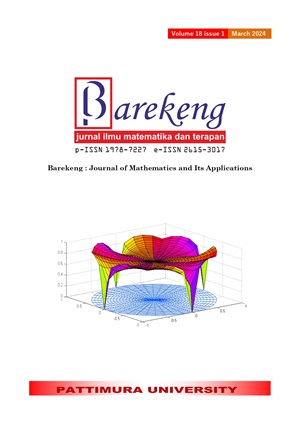NONLINEAR PRINCIPAL COMPONENT ANALYSIS IN PATH ANALYSIS WITH LATENT VARIABLES MIXED DATA
Abstract
This study aims to obtain the main component score of the ability to pay latent variable, determine the strongest indicators forming the ability to pay on a mixed scale based on defined indicators, and model the ability to pay on time mediated by fear of paying using path analysis. The data used in this study is secondary data from mortgage-paying customers with a sample size of 100. The method used is nonlinear principal component analysis with path analysis modeling. The results of this study indicate that the eleven variables formed by PC1 or X1 are able to store diversity or information by 32.50%, while 67.50% of diversity or other information is not stored (wasted). The credit term is the strongest indicator that forms the ability to pay variable. The variable ability to pay mortgages has a significant effect on payments by mediating the fear of paying late with a coefficient of determination of 80.40%.
Downloads
References
Z. Zefriyenni. “Kebijakan Pemberian Kredit Terhadap Penetapan Jumlah Kredit (Studi Khasus Pada Ued-Sp Amanah Sejahtera Sungai Buluh Kecamatansingingi Hilirkabupaten Kuantan Singingi Propinsi Riau).” Edik Inform.. vol. 1. no. 1. pp. 72–80. 2017. doi: 10.22202/ei.2014.v1i1.1443.
N. Wahyuni. “Penerapan Prinsip 5C Dalam Pemberian Kredit Sebagai Perlindungan Bank.” Lex J. Kaji. Huk. Keadilan. vol. 1. no. 1. 2017. doi: 10.25139/lex.v1i1.236.
A. A. R. Fernandes and Solimun. “Moderating effects orientation and innovation strategy on the effect of uncertainty on the performance of the business environment.” Int. J. Law Manag.. vol. 59. no. 6. pp. 1211–1219. 2017. doi: https://doi.org/10.1108/IJLMA-10-2016-0088.
S. Astutik. Solimun. and Darmanto. Multivariate Analysis: Theory and Application with SAS. Brawijaya Press University. 2018.
A. A. R. & N. Solimun. S; Fernandes. Metode Statistika Multivariat. Pemodelan Persamaan Struktural (SEM). Malang: UB Press. 2017.
A. M. Tamonob. A. Saefuddi. and A. H. Wigena. “Nonlinear Principal Component Analysis and Principal Component Analysis With Successive Interval in K-Means Cluster Analysis.” Forum Stat. Dan Komputasi. vol. 20. no. 2. pp. 68–77. 2015. [Online]. Available: https://journal.ipb.ac.id/index.php/statistika/article/view/16771
I. Djakaria. S. Guritno. and S. H. Kartiko. “Visualisasi Data Iris Menggunakan Analisis Komponen Utama dan Analisis Komponen Utama Kernel Visualization of Iris Data Using Principal Component Analysis and Kernel Principal Component Analysis.” J. ILMU DASAR. vol. 11. no. 1. pp. 31–38. 2017.
W. Härdle and L. Simar. “Applied Multivariate Statistical Analysis.” Appl. Multivar. Stat. Anal.. no. October. 2019. doi: 10.1007/978-3-662-05802-2.
I. T. Jolliffe and J. Cadima. “Principal Component Analysis: A Review and Recent Developments.” Philos. Trans. R. Soc. A Math. Phys. Eng. Sci.. vol. 374. no. 2065. p. 20150202. 2016. doi: https://doi.org/10.1098/rsta.2015.0202.
Y. Mori. M. Kuroda. and N. Makino. Nonlinear Principal Component Analysis and Its Applications. Springer Singapore. 2016. doi: https://doi.org/10.1007/978-981-10-0159-8.
C. C. David and D. J. Jacobs. “Principal component analysis: a method for determining the essential dynamics of proteins.” Protein Dyn. Methods Protoc.. vol. 1084. pp. 193–226. 2014. doi: https://doi.org/10.1007/978-1-62703-658-0_11.
H. Yu. F. Khan. and G. Ikram. “An alternative formulation of PCA for process monitoring using distance correlation.” Ind. Eng. Chem. Res.. vol. 55. no. 3. pp. 656–669. 2015. doi: https://doi.org/10.1021/acs.iecr.5b03397.
N. Kock. “Advantages of nonlinear over segmentation analyses in path models.” Int. J. E-Collaboration. vol. 12. no. 4. pp. 1–6. 2016. doi: https://doi.org/10.4018/ijec.2016100101.
M. B. T. Efendi. E.C.L.. Fernandes. A.A.R.. Mitakda. “Modeling of path nonparametric truncated spline linear. quadratic. and cubic in model on time paying bank credit.” Math. Stat. link is disabled. vol. 9. no. 6. pp. 947–957. 2021.
H. Katayama. Y. Mori. and M. Kuroda. “Variable Selection in Nonlinear Principal Component Analysis.” in Advances in Principal Component Analysis. IntechOpen. 2022. pp. 79–89. doi: http://dx.doi.org/10.5772/intechopen.103758.
Copyright (c) 2024 Rindu Hardianti, Solimun Solimun, Nurjannah Nurjannah

This work is licensed under a Creative Commons Attribution-ShareAlike 4.0 International License.
Authors who publish with this Journal agree to the following terms:
- Author retain copyright and grant the journal right of first publication with the work simultaneously licensed under a creative commons attribution license that allow others to share the work within an acknowledgement of the work’s authorship and initial publication of this journal.
- Authors are able to enter into separate, additional contractual arrangement for the non-exclusive distribution of the journal’s published version of the work (e.g. acknowledgement of its initial publication in this journal).
- Authors are permitted and encouraged to post their work online (e.g. in institutional repositories or on their websites) prior to and during the submission process, as it can lead to productive exchanges, as well as earlier and greater citation of published works.






1.gif)



